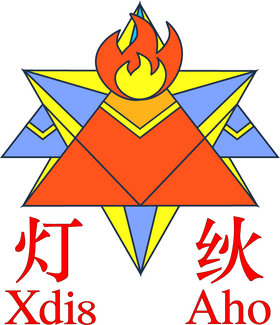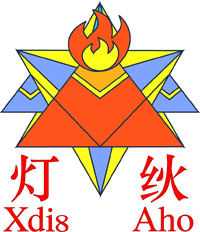Shidinn language:修订间差异
小无编辑摘要 |
无编辑摘要 |
||
| (未显示5个用户的28个中间版本) | |||
| 第1行: | 第1行: | ||
{{infobox | {{infobox | ||
|title= | |title=Shidinn<br />{{x|⇧xdi8 ⇧aho}} | ||
|image=Xdi8 Aho.png | |image=Xdi8 Aho.png | ||
|alt=[[希顶字母图腾|Totem of Shidinn alphabet]]<br />by [[用户:雨落寒江|雨落寒江]] | |alt=[[希顶字母图腾|Totem of Shidinn alphabet]]<br />by [[用户:雨落寒江|雨落寒江]] | ||
|-横栏=Chinese in Shidinn Script<br />{{x|⇧xdi8 ⇧aho fHLmA fa7Vi}} | |-横栏=Chinese in Shidinn Script<br />{{x|⇧xdi8 ⇧aho fHLmA fa7Vi}} | ||
|Inventor=[[黄雀飞|Huáng Quèfēi]] | |Inventor=[[黄雀飞|Huáng Quèfēi]] | ||
|Invented in=~ | |Invented in=~1995 | ||
}} | }} | ||
The '''Chinese in Shidinn Script''' (Shidinn: {{x|⇧xdi8 ⇧aho fHLmA fa7Vi}}, Pronunciation: / | The '''Chinese in Shidinn Script''' (Shidinn: {{x|⇧xdi8 ⇧aho fHLmA fa7Vi}}, Pronunciation: /ɕ(i).tĩ a.xo f(u).n͡zao.mu fa.tʰwei.(j)i//), commonly named '''Shidinn''', is a constructed language invented by folk linguist [[黄雀飞|Huáng Quèfēi]]. It is mainly based on one-to-one correspondance of Chinese characters. With 45 [[Shidinn alphabet|Shidinn letters]] of both phoneme and semantics, every single character includes zero to multiple semantic letters (radicals) and a complete syllable (phonetic series) which is [[Fiyifnzao (English)|an artificial phonology]] loosely based on southwestern Mandarin but not always comparable with Chinese as a sacrifice to more canonical phonotactis than Chinese. As a result, every character has a theoretical Shidinn pronunciation. | ||
Shidinn itself is an incomplete language, because grammar is missing apart from phonology and vocabulary. Huáng have devoted to developing a grammar but most of his manuscript have lost and his subsequent Shidinn texts are but transliteration of Chinese. There are some but not all Shidinidos adapting Huáng’s Shidinn phonology to new created grammar, including Common Shidinn, ‘Standard’ Shidinn, Shidio-Zhiyuanian. Therefore the term ‘Shidinn’ commonly refers to its determined part, i.e. phonology and vocabulary, similar to the concept of absolute geometry. | |||
== History == | == History == | ||
Named ''Xīnyǔ'' (新语, “the new language”) at first, Shidinn | Named ''Xīnyǔ'' (新语, “the new language”) at first, Shidinn was created by Huáng Quèfēi in the 1990s. It was renamed ''Xīdīngyǔ'' (西丁语) no later than 2017 and ''Xīdǐngyǔ'' (希顶语) in 2018, both being transliterations of ''Shidinn'' ({{x|xdi8}}, “lamp, torch”), while the latter conveys the meaning “summit of hope” (希望之顶). | ||
There are two reasons why Huáng was to invent Shidinn: alphabetical writing of Chinese and deprecation of homophones. Hanzi was not plain sailing in digital world in 1990s. A new form of Chinese with alphabet would be | There are two reasons why Huáng was to invent Shidinn: alphabetical writing of Chinese and deprecation of homophones. Hanzi was not plain sailing in digital world in 1990s. A new form of Chinese with an alphabet would be easier for a computer to handle, just like most of the other existing languages. Huáng believed that this will “internationalize” Chinese and make it easier for foreigners to grasp. Moreover, homophones are frequent in Chinese and, to make matters worse, there is no difference between ''n'' and ''l'' in some dialects. A Chinese variant without homophones will reduce mistakes in reading and writing. | ||
<ref>黄雀飞. 希顶字母华语创造者的采访传摘(一个朋友写的). https://www.bilibili.com/read/cv8981349/</ref><ref>黄雀飞. 我为什么要创造希顶字母? https://zhuanlan.zhihu.com/p/112110638</ref> | <ref>黄雀飞. 希顶字母华语创造者的采访传摘(一个朋友写的). https://www.bilibili.com/read/cv8981349/</ref><ref>黄雀飞. 我为什么要创造希顶字母? https://zhuanlan.zhihu.com/p/112110638</ref> | ||
Shidinn is mostly from Huáng’s inspiration. Huáng lived his life with adversity, | Shidinn is mostly from Huáng’s inspiration. Huáng lived his life with adversity, often designing the early forms of Shidinn in sorrow. He said, “Inspirations may come to me when I was dozily lying in bed, as if my soul had completely escaped my body.” The embryo of Shidinn thus gradually formed. | ||
Huáng wanted Shidinn to attain official recognition. So he went to Beijing twice, attempting to submit Shidinn to the government. The lack of budget forced Huáng to wander in Beijing. However, all his efforts ended up with failure. Huáng, desperate, switched his attention to netizens, and therefore posted Shidinn works online. | |||
On January 19, 2020, Huáng asked on Zhīhū, a Chinese question-and-answer website, “I suffered from chronic disaster since I invented the Shidinn alphabet. Is it because I have ruffled the Creator<ref>In Chinese mythology, people who did marvelous achievement often ruffled the Creator</ref> that my life is so sorrowful? Should I destroy the Shidinn alphabet?” (我创造了希顶字母,从此以后灾祸不断,是不是我触怒了天神,以之如此悲哀的人生,我是不是该毁灭希顶字母?) | |||
On | On February 18, Raymond posted [https://zhuanlan.zhihu.com/p/106197567 “Shidinn Language” Reveal] on Zhīhū, which drew the attention of professionals and amateurs in linguistics and created an upsurge of incubation and development of Shidinn. | ||
On | On September 5, Nyoeghau released the first version of the very first Shidinn typeface Gentium {{x|⇧xdi8}}, based on Gentium Plus, an open source font. | ||
On September | On September 17, Nyoeghau and 然後 established Zhīhū topic “Shidinn”. On October 19, QQ group of Shidinn was complete. On December 16, Bìlībìlī account @Xdi8Aho希顶社区 was created. On January 18, 2021, Shidinn Wiki was created. | ||
Many amateurs have contributed to Shidinn since its popularity online. Puzzles, proses, fictions, dramas and songs written in Shidinn established a unique style for Shidinn culture. Some Shidinn dialects was proposed based on Shidinn. Infrastructures, for instance fonts, convertors, input methods and operating systems were created as well. Though no sovereign states have officially acknowledged Shidinn, utilization of Shidinn is still on the rise. | |||
== See also == | |||
{{译文|zh = 希顶语|eo = Ŝidina lingvo|de = Shidinnische Sprache|ko = 시뎽어}} | |||
== Notes == | == Notes == | ||
<references /> | <references /> | ||
[[分类:English]] | |||
2023年4月5日 (三) 14:24的最新版本
| Shidinn | ||
 Totem of Shidinn alphabet by 雨落寒江 | ||
| Chinese in Shidinn Script | ||
| Inventor | Huáng Quèfēi | |
| Invented in | ~1995 | |
The Chinese in Shidinn Script (Shidinn: , Pronunciation: /ɕ(i).tĩ a.xo f(u).n͡zao.mu fa.tʰwei.(j)i//), commonly named Shidinn, is a constructed language invented by folk linguist Huáng Quèfēi. It is mainly based on one-to-one correspondance of Chinese characters. With 45 Shidinn letters of both phoneme and semantics, every single character includes zero to multiple semantic letters (radicals) and a complete syllable (phonetic series) which is an artificial phonology loosely based on southwestern Mandarin but not always comparable with Chinese as a sacrifice to more canonical phonotactis than Chinese. As a result, every character has a theoretical Shidinn pronunciation.
Shidinn itself is an incomplete language, because grammar is missing apart from phonology and vocabulary. Huáng have devoted to developing a grammar but most of his manuscript have lost and his subsequent Shidinn texts are but transliteration of Chinese. There are some but not all Shidinidos adapting Huáng’s Shidinn phonology to new created grammar, including Common Shidinn, ‘Standard’ Shidinn, Shidio-Zhiyuanian. Therefore the term ‘Shidinn’ commonly refers to its determined part, i.e. phonology and vocabulary, similar to the concept of absolute geometry.
History
Named Xīnyǔ (新语, “the new language”) at first, Shidinn was created by Huáng Quèfēi in the 1990s. It was renamed Xīdīngyǔ (西丁语) no later than 2017 and Xīdǐngyǔ (希顶语) in 2018, both being transliterations of Shidinn (, “lamp, torch”), while the latter conveys the meaning “summit of hope” (希望之顶).
There are two reasons why Huáng was to invent Shidinn: alphabetical writing of Chinese and deprecation of homophones. Hanzi was not plain sailing in digital world in 1990s. A new form of Chinese with an alphabet would be easier for a computer to handle, just like most of the other existing languages. Huáng believed that this will “internationalize” Chinese and make it easier for foreigners to grasp. Moreover, homophones are frequent in Chinese and, to make matters worse, there is no difference between n and l in some dialects. A Chinese variant without homophones will reduce mistakes in reading and writing. [1][2]
Shidinn is mostly from Huáng’s inspiration. Huáng lived his life with adversity, often designing the early forms of Shidinn in sorrow. He said, “Inspirations may come to me when I was dozily lying in bed, as if my soul had completely escaped my body.” The embryo of Shidinn thus gradually formed.
Huáng wanted Shidinn to attain official recognition. So he went to Beijing twice, attempting to submit Shidinn to the government. The lack of budget forced Huáng to wander in Beijing. However, all his efforts ended up with failure. Huáng, desperate, switched his attention to netizens, and therefore posted Shidinn works online.
On January 19, 2020, Huáng asked on Zhīhū, a Chinese question-and-answer website, “I suffered from chronic disaster since I invented the Shidinn alphabet. Is it because I have ruffled the Creator[3] that my life is so sorrowful? Should I destroy the Shidinn alphabet?” (我创造了希顶字母,从此以后灾祸不断,是不是我触怒了天神,以之如此悲哀的人生,我是不是该毁灭希顶字母?)
On February 18, Raymond posted “Shidinn Language” Reveal on Zhīhū, which drew the attention of professionals and amateurs in linguistics and created an upsurge of incubation and development of Shidinn.
On September 5, Nyoeghau released the first version of the very first Shidinn typeface Gentium , based on Gentium Plus, an open source font.
On September 17, Nyoeghau and 然後 established Zhīhū topic “Shidinn”. On October 19, QQ group of Shidinn was complete. On December 16, Bìlībìlī account @Xdi8Aho希顶社区 was created. On January 18, 2021, Shidinn Wiki was created.
Many amateurs have contributed to Shidinn since its popularity online. Puzzles, proses, fictions, dramas and songs written in Shidinn established a unique style for Shidinn culture. Some Shidinn dialects was proposed based on Shidinn. Infrastructures, for instance fonts, convertors, input methods and operating systems were created as well. Though no sovereign states have officially acknowledged Shidinn, utilization of Shidinn is still on the rise.
See also
In other languages
- 本页中文版见希顶语。
- Esperanta versio de ĉi tio artikolo estas Ŝidina lingvo.
- Die deutsche Version dieses Artikels ist Shidinnische Sprache.
- 이 기사의 한국어 버전은 시뎽어입니다.
Notes
- ↑ 黄雀飞. 希顶字母华语创造者的采访传摘(一个朋友写的). https://www.bilibili.com/read/cv8981349/
- ↑ 黄雀飞. 我为什么要创造希顶字母? https://zhuanlan.zhihu.com/p/112110638
- ↑ In Chinese mythology, people who did marvelous achievement often ruffled the Creator
